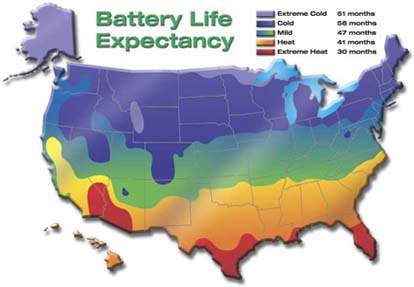
[Source: Interstate Batteries]
Last Updated on October 28, 2007
Normally, premature battery failures are caused by one or more of the failures listed below with water loss and sulfation the main offenders. Prior to 1980, plate or grid shorts were the most common failure. Since then the manufacturers have significantly improved the life expectancy by using better separators, plate alloys to reduce corrosion, and heat shields. Relocating starting batteries to the passenger compartment (or trunk) also has considerably decreased premature battery failures. Batteries that have been in use for longer periods of time will typically fail from multiple causes. All batteries will fail at some point in time from old age (positive plate shedding of active material or grid corrosion).

[Source: Interstate Batteries]
12.1. For wet car batteries, lack of preventive maintenance, high underhood heat, fast recharging (greater than C/4), or overcharging causes a loss of water, which accounts for over 50% of the failures. For wet motive and stationary deep cycle batteries, water loss due to the lack of preventive maintenance or overcharging is the main culprit. Please see Section 3 for more information on preventive maintenance.
12.2. Sulfation from water loss, undercharging, electrolyte stratification (especially in larger batteries over a 100 amp hours), using tap water, excessive temperatures, or prolonged periods of non-use account for approximately 85% of the deep cycle and starting battery failures that are not used weekly (or bi-weekly in colder climates). Some vehicle charging systems based on driving habits (short trips or high loads) leave the car battery constantly undercharged and sulfated. Please see Section 16 for more information on sulfation.
12.3. Battery post or terminal corrosion, which cause charging and discharging problems. Please see Section 3 for more information on preventive maintenance.
12.4. High ambient temperatures above 77° F (25° C) causing accelerated positive grid growth or corrosion, increased self-discharge, or thermal runway in AGM (Ca/Ca) and Gel Cell (Ca/Ca) VRLA batteries. For every increase of 18° F (10° C) above 77° F (25° C), the battery's life is cut in half due to positive grid corrosion or the self-discharge rate is doubled.
12.5. Excessive deep discharges below 10.5 volts, such as leaving your vehicle's lights on.
12.6. Misapplication, for example, using a starting battery in a deep cycle application, a motive deep cycle battery instead of a stationary for a UPS, or an undersized battery (or battery bank) that causes discharges greater than the battery was designed for or will not produce enough capacity.
12.7. Plate-to-strap shorts due to excessive vibration caused by loose hold down clamps or vehicle running on rough surfaces or freezing.